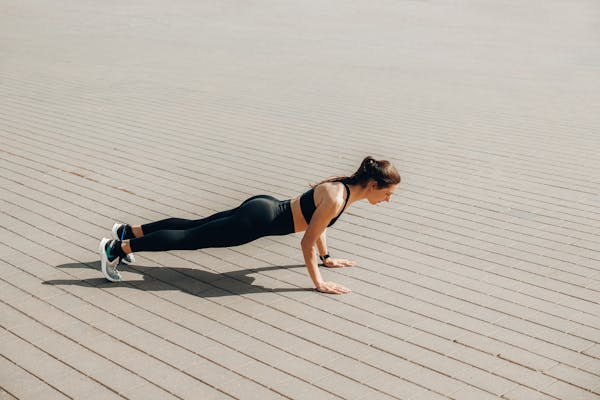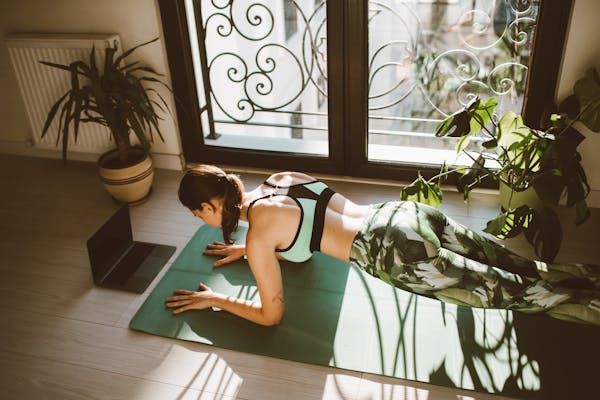I know what planking can do for my body, but I still struggled with motivation along the way.
Call me a masochist, but I love a good plank.
Bodyweight exercises, like the good old plank, are simple to work into your fitness routine because they require no extra gear. For awhile, I lost sight of the obvious benefits of planking, so we went on hiatus. I would usually throw in a few plank holds after some post-run squats and crunches, but one day I was running late for a meeting and thought, “I’ll skip them just this once.” And, of course, I never planked again that entire season.
That’s what happens. You think these movements are so small they don’t matter, but they totally do. So what does planking do for your body? It doesn’t just work your abdominal muscles, but your entire core, and can even help you build strength in your shoulders, chest, upper back, and thighs. So yeah, there are plenty of reasons why planks are good for the body.
:max_bytes(150000):strip_icc():format(webp)/fb-woman-planking-644a2500fcb4416995dee1048114f43c.jpg)
I recently realized my core felt like a loaf of sourdough bread and my back ached like I was 90. So I told myself it’s time to re-plank my way to fitness.
One proven way to start a new habit (and stay committed to it) is by setting a goal, so I gave myself the target of planking five minutes a day for an entire month. The five minutes didn’t have to be consecutive, but the amount of work needed to add up to that. I ended up learning much more-about my routines, my feelings about exercise, and why sprinting toward a finish line might not always work.
Before starting, I asked Steph Creaturo, yoga teacher, run coach, and planking fiend, what I should keep in mind during every plank. Engaging your transverse abdominis — the deep core abdominal muscle that’s responsible for flattening your abs and stabilizing your core from front to back — while you plank is key, she says. “It takes stress off the low back and brings all the other key plank muscles-hamstrings, butt, quads-to the party in spades.”
With that, I set some ground rules: Five minutes total, can be divided however I like, and plank variations are welcome. Then I got started.
Plank Challenge: Week 1
Day 1: It’s the first minute of my first plank and there’s nothing but me, my living room floor, dead silence, and the timer on my iPhone. One timer dings. I move from a forearm plank to a side plank. Great! Ding. Another side plank. Three tiny beads of sweat form on my forehead. I try to focus on the thought “What does planking do for you?” I take a little break then eke my way through the other planks and have one thought: “Twenty-nine more days?”
Day 2: Instead of conquering my five minutes’ worth of planks all in a row, I decide to separate them between sprints of work. Ideally, this would force me to get up from my desk and use the rest of my body for 60 seconds at a time. Not so ideal: I do two plank holds, forget about the rest until after dinner, and am forced to do the remaining minutes on a full stomach. I do not recommend this.
Day 3: Yep, more planks. Forearm planks, side planks, and straight-arm planks are my sweet spot, but I flirt with the idea of planks with leg lifts until-nope, yeah, gonna have to work up to that.
Day 4: Oops, forgot to plank today, but I think I’ve discovered the problem. Habits get locked in when they’re instituted by a trigger action. (Changing into pajamas signals it’s time to brush your teeth, etc.) I haven’t found a trigger for my planking, and what doesn’t get scheduled doesn’t get done.
Day 5: Aha! Here’s my trigger action — running. I do my two sets of five-minute planks (making up for yesterday) right after a nighttime run and my other core exercises. They’re getting slightly easier.
Day 6: Since I don’t have plans to run today, I try to knock out my quota in the morning. Sleepy arms don’t like planks, but I do find one new trick. Instead of setting a one-minute alarm five times, I download a timer app, which can be programmed to automatically reset a one-minute timer. No breaks, but I’m finished much faster.
Day 7: Now I’m really getting creative. Full plank, forearm plank, side planks, and a bicycle plank. (OK, maybe I made this exercise up, but I felt like moving my legs.)

Plank Challenge: Week 2
Day 8: Time to check up on proper plank form. I realize my back and hips are dipping, so I focus on engaging my core like I’m about to get punched in the stomach — and whaddya know, the planks become both easier (I feel much more solid) and harder (all the other muscles I was ignoring begin to activate).
Day 9: I turn on a short YouTube workout video to watch instead of my timer and it helps the seconds tick by. And then 20 minutes pass and I realize I’m still lying on the floor watching YouTube in my workout clothes.
Day 10: Five solid planks before showering in the morning. Boom.
Day 11: I’m so busy with work and deadlines that exercise is the last thing on my mind. I forget to plank.
Day 12: I forget to plank again. I think about how finding time for exercise can feel like a luxury. In the hierarchy of daily priorities, something’s always gotta give.
Day 13: I remember to plank, but don’t feel like it. Not going to lie, I feel pretty guilty.
Day 14: Why do we self-sabotage our exercise habits? This is a real question. There are 1,440 minutes in a day, and this activity only takes up five. Instead of planking, I probably spent a half hour telling myself “don’t forget” and another five minutes lying in bed thinking “you forgot.” I fall asleep.
Plank Challenge: Week 3
Day 15: Determined to make up for my failures, I resolve that this is going to happen. I get down on the floor, set my timer, and planking is hard again. I feel like I’ve gone backward, and the struggle is real.
Day 16: I don’t…feel…like…planking. Period.
Day 17: I don’t plank, and in the process, I learn something new about myself. When I feel forced to do something, I can quickly grow to resent it. And right now doing five minutes of planks no longer feels like a choice. It feels like a chore.
Day 18: Planking today feels like doing the dishes or remembering to take out the trash. I wonder if I’d feel differently if I tweaked my goal, such as increasing my time by planking longer instead of doing the same one-minute rounds five times every day. I decide to stick to my original plan and opt for that challenge another day.
Day 19: Suddenly, another big problem with this challenge dawns on me. Toward the beginning of the 30-day sprint, I got injured and stopped my marathon training. Running was the anchor to all my other exercise — strength training was a complement to my running, so when there’s no running, everything else kind of falls away. I tell myself that I need to reframe these planks as something that’s necessary to keep me healthy so when I do run again, I’m healthier and stronger because of them. It’s all a matter of asking yourself “What does planking do for you?”
Day 20: Feeling positive, I do a plank with a leg lift. Then, a high plank with a shoulder touch and a high plank with an arm raise. I’m a planking machine!
Day 21: After a busy day of meetings and deadlines, I forget to plank again.

Plank Challenge: Week 4
Day 22: Planks done.
Day 23: Done again!
Day 24: Today they’re easier than ever, and I feel stronger.
Day 25: I’m lying in bed, about to drift off, and realize-yup, I forgot. Or rather, I avoided. But this time, I crawl out of bed, get down on the floor, and plank my tired heart out. It feels good. I think I dream of planks.
Day 26: Looking at the calendar makes me a little sad to think I’ll soon be finished with this 30-day challenge, yet also grateful that I won’t have them hanging over my head. While challenges are extraordinarily useful in keeping up regular progress, it occurs to me that I didn’t have anything to hold me accountable (besides writing this story, of course). If I had roped in an unsuspecting friend to do them with me, we could have supported and pushed each other. I was missing that motivation.
Day 27: I try to do a plank with a push-up. They’re fun but hard. I miss running, but I remember this will help me run.
Day 28: The five minutes go by so quickly that I decide to throw in one more plank for good measure.
Day 29: Done. Done. Done. Done. Done. I feel like I’m going to miss the little patch of living room rug I’ve stared at (almost) every day for the past month.
Day 30: I have planked my way to victory!
Plank Challenge: Lessons Learned
Not every day was successful. I forgot some days, and I dodged some others, but that’s the biggest lesson I’ve learned in this challenge — things happen. Treating each day like a short chance to accomplish micro goals was helpful. The point was to challenge myself mentally and physically. And now my biceps are a little more toned, and my back doesn’t hurt anymore, so you know what? I might try again tomorrow.